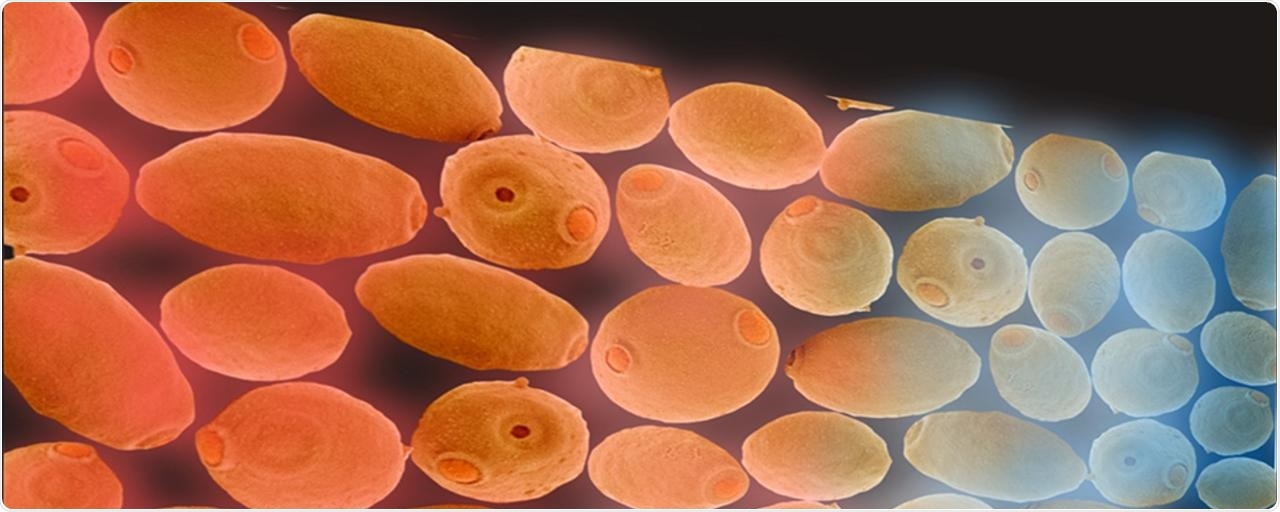A better understanding of cellular interactions is crucial to interpret several biological diseases and systems.

By studying yeast cells, researchers have successfully mapped how cells communicate and synchronize their behavior. Image Credit: University of Gothenburg.
Now, a team of scientists headed by researchers from the University of Gothenburg has employed an exclusive combination of techniques to plot the mechanism behind cellular interaction. The new findings could shed more light on the fundamental mechanism behind type 2 diabetes.
Human communication is known to be very crucial; however, the interaction between the cells in human bodies is equally important. The process through which cells synchronize and coordinate their actions is needed for an organism to function and for human organs to have the capacity to execute their functions.
How do cells go from monologues to dialogues? How do cells transit from acting as individuals to acting as a community? We need to better understand this complex and difficult-to-study behavior.”
Caroline Beck Adiels, Senior Lecturer, Department of Physics, University of Gothenburg
Finds the mechanism behind cellular communication
Beck Adiels is responsible for the new research work recently published in the PNAS scientific journal, in which the team defined a technique for examining cellular communication. In the new study, the researchers effectively plotted the mechanism behind cellular interaction in the metabolic process, with the help of tiny culture chambers that help control the environment around the cells.
The investigators opted to examine yeast cells, as these cells are analogous to human cells, and the team’s target is glycolytic oscillations—a sequence of chemical reactions that occur during metabolism, and in which the substance concentration can oscillate or pulse. The study revealed how cells that originally oscillated independently of each other changed to being more synchronized, producing partly synchronized populations of cells.
One of the unique things with this study is that we have been able to study individual cells instead of simply entire cell populations. This has allowed us to really be able to see how the cells transition from their individual behavior to coordinating with their neighbors. We have been able to map their behavior both temporally and spatially, that is to say, when something occurs and in which cell.”
Caroline Beck Adiels, Senior Lecturer, Department of Physics, University of Gothenburg
Opens up opportunities for understanding type 2 diabetes
This insight can be used in several other biological systems as well in more complex cells, where coordinated behavior of cells plays a key role, added Beck Adiels. This kind of behavior is even found in cells, like pancreatic cells and heart muscle cells, which can be a crucial piece of the puzzle in diabetes studies.
The study can contribute to understanding how pancreatic cells are regulated and how they secrete insulin, which can help us understand the underlying mechanism behind type 2 diabetes. Eventually, this could contribute to developing new medicines for treating the disease.”
Caroline Beck Adiels, Senior Lecturer, Department of Physics, University of Gothenburg
The research work is teamwork between eight scientists at Swedish and international universities, and Caroline Beck Adiels highlighted that this interdisciplinary association has been integral in investigating the complex cell behavior from various perspectives.
“I am very proud of this work, which had not been possible to complete if we had not collaborated across disciplines,” Beck Adiels concluded.
Source:
Journal reference:
Mojica-Benavides, M., et al. (2021) Intercellular communication induces glycolytic synchronization waves between individually oscillating cells. Proceedings of the National Academy of Sciences. doi.org/10.1073/pnas.2010075118.